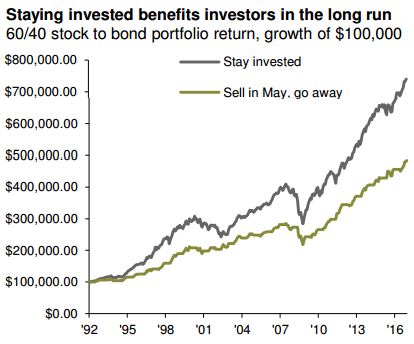Should I Stay or Should I Go?
Sell in May and go away. Have you ever heard that market maxim? An old saying believed to stem from British aristocrats who fled the summer heat of London, "Sell in May" is a popular adage. Investors should sell at the end of April and then buy back their investments in the Fall, or so the saying goes.
The idea is to skip the stock market's summer doldrums, when traders, just like the aristocrats before them, leave town for long vacations and presumably lose interest in investing. This lack of attention slows things down a bit, often leading to flat markets during the summer.
In reality there is something to the idea. Bespoke Investment Group has done a lot of analysis on the topic and finds that during the last 50 years, the Dow (an index of 30 large U.S. stocks) averaged down by -0.01% in May but was positive 50% of the time. June averaged a slightly larger decline of -0.24% and was positive 48% of the time. August and September also followed this trend with the Dow not picking back up again, on average, until October.
The historical data shows a meaningful difference between spring and summer returns and returns from November through April. This might lead investors to assume they could earn higher returns by trying to "trade" what they see as an obvious seasonal pattern. But from the standpoint of being prudent, it's better to hold stocks during this generally slower period and if you "go away", maybe it should be on vacation while leaving your investments alone.
Why? Because the numbers above are averages, meaning that some of the returns were better and some were worse. And of course, we don't know in advance which this summer will bring, positive or negative returns. So, "Sell in May and go away" is just like many other market maxims in that it's interesting historical information and good for conversation, but it's not a sound investment strategy.
Over the long term, it's better for investors to err on the side of holding through the summer and, instead of selling and going away, simply resetting expectations for growth. This is helpful over time, especially while holding a diversified portfolio that includes bonds because interest and dividends continue to come in and compound, adding to the potential for growth.
The following chart from JP Morgan shows how staying invested during the summer months beats the alternative over the past 25 years. The firm found that, "... an investor in a 60/40 stock and bond portfolio using the "Sell in May" strategy would have missed out on $255K over 25 years compared with an investor who stayed the course." There you have it.

Oh, and coincidentally, that difference just about covers what Fidelity expects the average healthcare cost will be for a couple in retirement ($260K). So, taking the long view with investing is an important aspect of ensuring you meet your goals. Don't get too caught up in catchy market maxims.
Have questions? Ask me. I can help.
- Created on .



